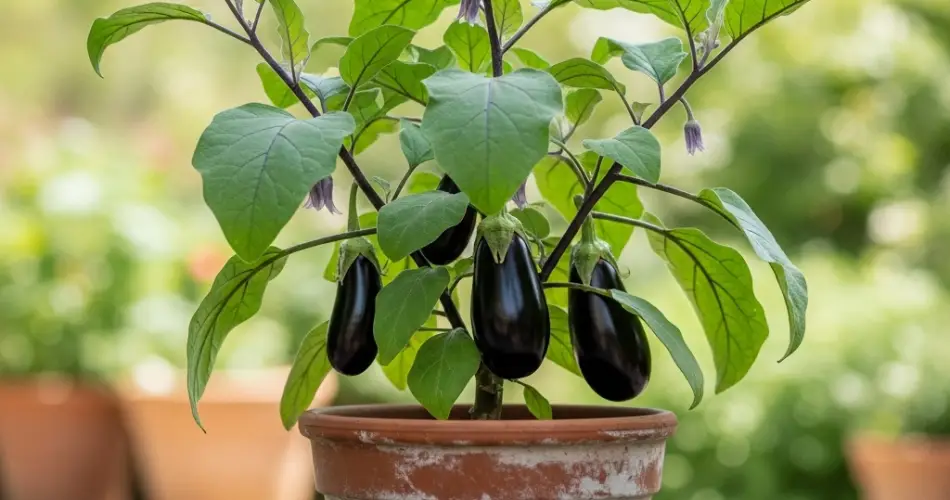Eggplants, also known as aubergines, are a warm-season crop prized for their glossy fruits and rich flavor. While they’re typically grown in garden beds, eggplants adapt surprisingly well to pots—making them a perfect choice for balcony gardening. With a sunny spot, a suitable container, and some attentive care, you can enjoy large, healthy fruits even in a small urban space.
Choosing the Right Container
Eggplants have a strong root system and need room to develop fully. Select a pot that’s at least 30–40 cm (12–16 inches) deep and equally wide. A 15-liter (4-gallon) container is the minimum size for a single plant, but bigger is always better when it comes to fruiting vegetables.
Use containers with good drainage holes at the bottom. Clay, ceramic, or plastic pots all work well, and fabric grow bags are also an excellent option because they allow better airflow and prevent root binding.
Preparing the Ideal Soil
Eggplants thrive in loose, fertile, and well-draining soil rich in organic matter. Use a high-quality potting mix and enrich it with compost or aged manure. You can also prepare your own soil blend by mixing garden soil with compost, coconut coir or peat moss, and a handful of perlite or sand for aeration.
The ideal soil pH for eggplants is between 6.0 and 6.8. Mix in a slow-release organic fertilizer before planting to support the plant through its initial growth stages.
Planting Your Eggplants
You can start eggplants from seeds or purchase healthy seedlings from a nursery. If starting from seeds, sow them indoors 6–8 weeks before your last expected frost date. Transplant them into your containers once the seedlings are 10–15 cm (4–6 inches) tall and the weather is consistently warm.
Plant one eggplant per pot to avoid overcrowding. If using a long rectangular container, you can plant two seedlings as long as there’s at least 45 cm (18 inches) of space between them.
After planting, water thoroughly and place the container in a warm, sunny location.
Light and Temperature Requirements
Eggplants love warmth and sunlight. They need at least 6–8 hours of direct sun each day to produce healthy fruits. A south- or west-facing balcony is ideal.
These heat-loving plants also prefer temperatures between 21–30°C (70–86°F). If nights are cool in your area, consider bringing pots indoors or using a cloche or plastic cover to trap warmth during early growth stages.
Watering Tips
Eggplants in containers need consistent moisture, especially while flowering and fruiting. Water when the top 2–3 cm (about an inch) of soil feels dry. Use a watering can with a narrow spout to avoid splashing the leaves, which can lead to fungal diseases.
Avoid overwatering, but don’t let the soil dry out completely either—eggplants are sensitive to water stress, which can cause flowers to drop or fruits to become misshapen.
Mulching the soil surface with straw or dry leaves can help retain moisture and keep roots cool.
Fertilizing for Bigger Fruits
To support strong growth and fruit production, feed your eggplants every two to three weeks with a balanced liquid fertilizer or compost tea. Once the plant starts flowering, switch to a fertilizer higher in phosphorus and potassium to promote more blooms and fruit development.
Avoid overusing nitrogen-heavy fertilizers, as they can lead to excessive leaf growth and few fruits.
Supporting Your Plants
As eggplants grow and begin to bear fruit, their stems may become heavy and prone to bending or breaking. Stake your plants early using bamboo sticks, tomato cages, or other supports to keep them upright and stable.
Tie the main stem loosely to the support using garden twine or soft plant ties to prevent damage.
Dealing with Pests and Problems
Eggplants are susceptible to pests such as aphids, spider mites, flea beetles, and whiteflies. Check the undersides of leaves regularly and remove pests by hand or with a gentle spray of soapy water.
Neem oil or insecticidal soap can also be used to manage infestations naturally. Make sure your plants have good air circulation to prevent fungal diseases like powdery mildew or blight.
Remove any yellowing or damaged leaves promptly and keep the area around the pots clean.
Harvesting Eggplants
Eggplants are ready to harvest when the fruits are glossy and firm. The size depends on the variety, but in general, don’t wait too long—overripe eggplants can turn bitter and develop tough skins.
Use a sharp knife or garden shears to cut the fruit from the stem, leaving a short piece of stem attached to avoid damaging the plant.
Check your plants frequently, as harvesting regularly encourages the production of new fruits.
Extend the Season and Regrow
In tropical or mild climates, eggplants can be grown year-round. In cooler zones, treat them as annuals or bring containers indoors before the first frost. With good care, a potted eggplant can produce fruit for several months.
You can also try saving seeds from your healthiest fruits or propagate new plants from cuttings for the next growing season.
Growing eggplants in pots is a practical and satisfying way to produce large, flavorful fruits in a limited space. Whether you’re working with a small balcony or a sunny corner of your patio, this vibrant and productive plant is a great addition to your container garden. With a little sunlight, warmth, and regular care, you’ll soon be harvesting your own homegrown eggplants straight from the pot.



